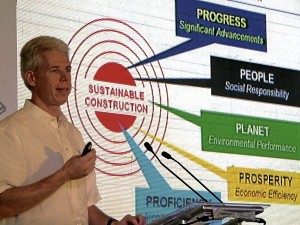PPP projects seen boosting cement sales
Cement maker Holcim Philippines sees a double-digit growth in cement business this year on the back of an accelerated government spending and steady rollout of construction projects by the private sector.
For the full year, Holcim aims to grow its sales volume by about 10 percent to six million metric tons equivalent to about 150 million bags of cement, Holcim chief operating officer Roland Van Wijnen said in a briefing.
In the first half, Holcim sold 3.3 million metric tons of cement, more than 20 percent higher than the level a year ago.
Holcim grew its first-semester net profit by 40 percent to P2.02 billion. For the second quarter, its net profit surged by 94 percent year on year to P1.21 billion as sales volume hit a record high, with demand peaking in May.
Van Wijnen expects a cyclical dip in demand in the second half as construction slows due to the rainy reason. He sees sales this year exceeding year-ago level, as public-private partnership projects are expected to finally start while election-related spending trickles in.
Article continues after this advertisement“In anticipation of the sustained strong demand, we will be reviving our grinding plant in Mabini, Batangas, to add up to 22.5 million bags to our capacity when it opens next year. This facility will allow us to supply one of the fastest-growing areas in Southern Luzon,” Van Wijnen said.
Article continues after this advertisementHolcim’s six-month net sales surged to P13.82 billion from P11.16 billion in the same period last year. Income from operations in the first semester jumped to P3 billion from P2.32 billion over the same period.
“We see that the government’s effort to reform the system for public spending is contributing to a reinvigorated construction industry,” Van Wijnen said. “With strong infrastructure activities, the construction industry is again running on two legs as it did in 2010, when the construction industry contributed to strong economic growth.”
Van Wijnen said Holcim’s performance mirrored the strong industry growth as government pushed infrastructure projects while the private sector sustained robust construction activities, particularly for residential and commercial sectors.
Holcim generated 35-40 percent of its first-semester business from the public sector—such as regular public works and local government unit projects while the rest was fueled by the private sector, said Holcim vice president Eduardo Sahagun.
But apart from a robust market, Holcim’s strong first-semester results were attributed to its customer focus, improvements in manufacturing facilities and effective cost management.
The utilization rate of Holcim’s manufacturing facilities is currently above 80 percent.
Its six plants have a capacity to produce 6.6 million MT clinker and 8-8.5 million MT of cement each year. The company estimates its market share at about 34-35 percent.—Doris C. Dumlao
